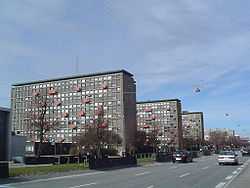Hans Christian Ørsted Institute


The Hans Christian Ørsted Institute at the University of Copenhagen is a building complex that houses the departments of Mathematics and Chemistry, as well as part of Physics. It is named after the physicist Hans Christian Ørsted (1777–1851), who discovered electromagnetism (1820) and was the first to isolate aluminium (1825). By students and staff the institute is commonly called simply "HCØ".
The complex is made up of five connected buildings: A, B, C, D and E.
Building A is a long connecting building, it has ground, first floor and basement level and holds the auditoria.
Building B is a five floor building, and holds facilities for inorganic (ground, first and second level) and organic chemistry (3rd, fourth and fifth level). In the basement of the building is a mass spectrometry apparatus. Building C is a five floor building similar to building B and holds the sections for theoretical chemistry and spectroscopy. Building D is a five floor building similar to B and C, but this is dedicated to physics and is as such part of the Niels Bohr Institute. It holds the Ørsted Laboratory.
Building E is another type building, not as large as the other three. It holds the mathematical section.
Coordinates: 55°42′02″N 12°33′40″E / 55.70056°N 12.56111°E